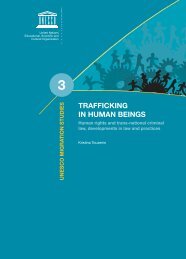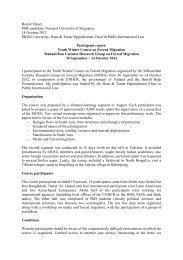Preventive Detention, Suspected Terrorists, and War
Preventive Detention, Suspected Terrorists, and War
Preventive Detention, Suspected Terrorists, and War
You also want an ePaper? Increase the reach of your titles
YUMPU automatically turns print PDFs into web optimized ePapers that Google loves.
COLE FINAL<br />
7/1/2009 12:43 AM<br />
710 CALIFORNIA LAW REVIEW [Vol. 97:693<br />
detention in the pretrial-detention context may be imposed only if the criminalprosecution<br />
model cannot adequately address the state’s compelling interests in<br />
protecting the community or precluding flight of a criminal defendant, it lasts<br />
only for a limited period of time, <strong>and</strong> it includes a fair, individualized<br />
determination that detention is necessary. 76<br />
Civil commitment, like detention pending trial, also addresses a scenario<br />
in which criminal prosecution cannot adequately address danger to the<br />
community. Persons who lack the requisite mental capability to distinguish<br />
right from wrong or to control their own actions generally cannot be held<br />
criminally liable. Yet they may pose a serious danger to the community. The<br />
Court has accordingly upheld civil commitment where an individual is found,<br />
after a fair adversarial proceeding, to be a danger to himself or others <strong>and</strong> to<br />
have a mental illness or abnormality that makes it “‘difficult, if not impossible,<br />
for the [dangerous] person to control his dangerous behavior.’” 77 The latter<br />
showing is particularly essential “lest ‘civil commitment’ become a<br />
‘mechanism for retribution or general deterrence’—functions properly those of<br />
criminal law, not civil commitment.” 78<br />
Commitment for dangerousness alone is not constitutionally permitted. In<br />
Foucha v. Louisiana, the Court invalidated a Louisiana statute that authorized<br />
civil commitment on a finding of dangerousness without any finding of mental<br />
illness, stressing that our present system, “with only narrow exceptions <strong>and</strong><br />
aside from permissible confinements for mental illness, incarcerates only those<br />
who are proved beyond reasonable doubt to have violated a criminal law.” 79<br />
The civil commitment cases thus underscore that criminal prosecution is, as a<br />
constitutional matter, the presumptive route for addressing socially dangerous<br />
behavior, <strong>and</strong> that preventive detention is permissible only where for some<br />
reason the criminal process cannot adequately address dangerousness.<br />
The maxim that civil commitment may not be imposed for purposes of<br />
retribution or general deterrence also supports the requirement that detention be<br />
predicated on an individualized showing of need. One might otherwise contend<br />
76. Analogous reasoning supports preventive detention of foreign nationals charged with<br />
deportation pending the outcome of their proceedings, provided they pose a risk of flight or a<br />
danger to the community. See David Cole, In Aid of Removal: Due Process Limits on Immigration<br />
<strong>Detention</strong>, 51 Emory L.J. 1003, 1029 (2002); see, e.g., Zadvydas v. Davis, 533 U.S. 678, 690-91<br />
(2001).<br />
77. Kansas v. Crane, 534 U.S. 407, 411 (2002) (quoting Kansas v. Hendricks, 521 U.S.<br />
346, 358 (1997)).<br />
78. Id. at 412 (quoting Hendricks, 521 U.S. at 372-73 (Kennedy, J., concurring)). To the<br />
same effect, the Crane Court stated that this requirement was designed “to distinguish the<br />
dangerous sexual offender whose serious mental illness, abnormality, or disorder subjects him to<br />
civil commitment from the dangerous but typical recidivist convicted in an ordinary criminal<br />
case.” Id. at 413. Similarly, in Hendricks, the Court explained that the requirement of a harmthreatening<br />
mental illness “serve[s] to limit involuntary civil commitment to those who suffer<br />
from a volitional impairment rendering them dangerous beyond their control.” Hendricks, 521<br />
U.S. at 358.<br />
79. 504 U.S. 71, 83 (1992).

















